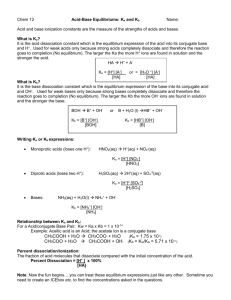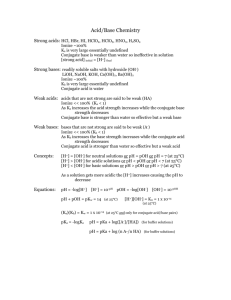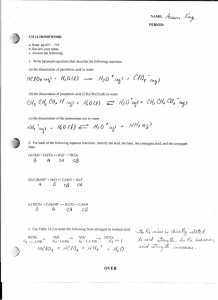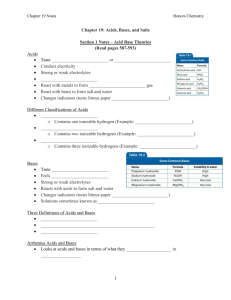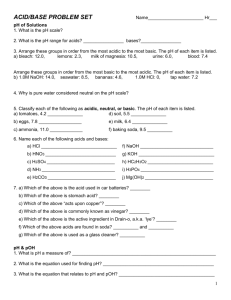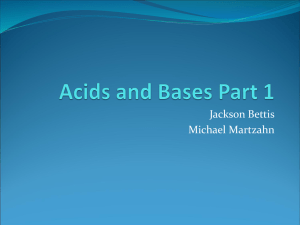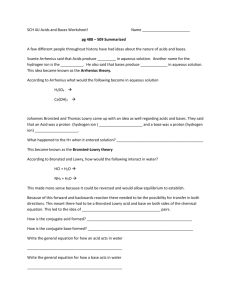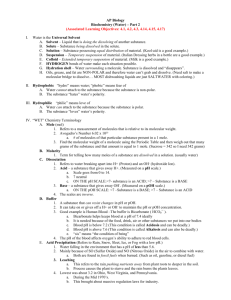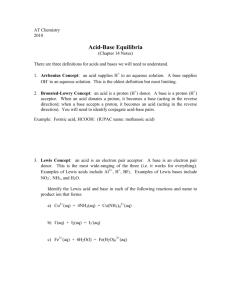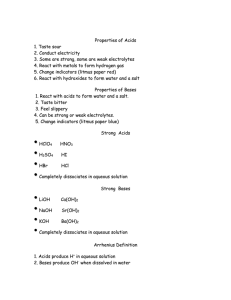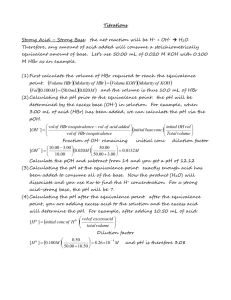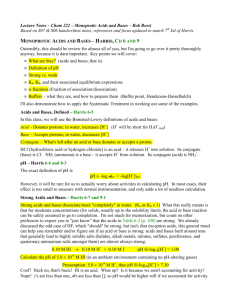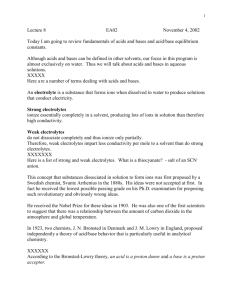ACID-BASE EQUILIBRIUM
advertisement
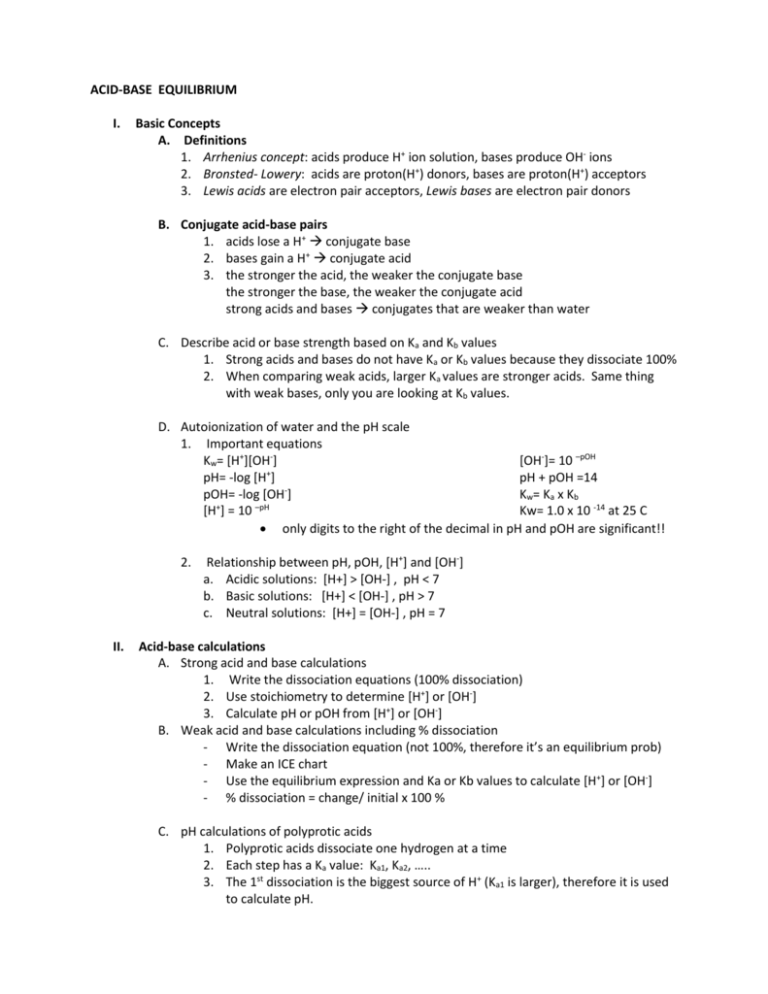
ACID-BASE EQUILIBRIUM I. Basic Concepts A. Definitions 1. Arrhenius concept: acids produce H+ ion solution, bases produce OH- ions 2. Bronsted- Lowery: acids are proton(H+) donors, bases are proton(H+) acceptors 3. Lewis acids are electron pair acceptors, Lewis bases are electron pair donors B. Conjugate acid-base pairs 1. acids lose a H+ conjugate base 2. bases gain a H+ conjugate acid 3. the stronger the acid, the weaker the conjugate base the stronger the base, the weaker the conjugate acid strong acids and bases conjugates that are weaker than water C. Describe acid or base strength based on Ka and Kb values 1. Strong acids and bases do not have Ka or Kb values because they dissociate 100% 2. When comparing weak acids, larger Ka values are stronger acids. Same thing with weak bases, only you are looking at Kb values. D. Autoionization of water and the pH scale 1. Important equations Kw= [H+][OH-] [OH-]= 10 –pOH pH= -log [H+] pH + pOH =14 pOH= -log [OH-] Kw= Ka x Kb [H+] = 10 –pH Kw= 1.0 x 10 -14 at 25 C only digits to the right of the decimal in pH and pOH are significant!! 2. II. Relationship between pH, pOH, [H+] and [OH-] a. Acidic solutions: [H+] > [OH-] , pH < 7 b. Basic solutions: [H+] < [OH-] , pH > 7 c. Neutral solutions: [H+] = [OH-] , pH = 7 Acid-base calculations A. Strong acid and base calculations 1. Write the dissociation equations (100% dissociation) 2. Use stoichiometry to determine [H+] or [OH-] 3. Calculate pH or pOH from [H+] or [OH-] B. Weak acid and base calculations including % dissociation - Write the dissociation equation (not 100%, therefore it’s an equilibrium prob) - Make an ICE chart - Use the equilibrium expression and Ka or Kb values to calculate [H+] or [OH-] - % dissociation = change/ initial x 100 % C. pH calculations of polyprotic acids 1. Polyprotic acids dissociate one hydrogen at a time 2. Each step has a Ka value: Ka1, Ka2, ….. 3. The 1st dissociation is the biggest source of H+ (Ka1 is larger), therefore it is used to calculate pH. 4. Special case: sulfuric acid a. 1st dissociation is a strong acid, 2nd dissociation is a weak acid b. [H2SO4] > 1 M, 1st step is the dominant source of H+ - strong acid problem c. [H2SO4] <1 M, Combine the [H+] from both steps D. acid-base properties of salts If the cation is from And the ion is from: Then the salt is: Example A strong base A strong acid Neutral (pH=7) NaCl, KNO3 A strong base A weak acid Basic (pH > 7) NaF, KCN A weak base A strong acid Acidic (pH < 7) NH4Cl A weak base A weak acid Acidic if Ka> Kb NH4CN, Basic if Kb > Ka NH4C2H3O2 Neutral if Ka=Kb III. Buffer Solutions A. Buffer solutions 1. contain a weak acid and its conjugate or a weak base and its conjugate 2. resist a change in pH when a strong acid or base is added to the solution B. Calculations involving buffers: 1. H+ ions must act completely with the best base 2. OH- must act completely with the best acid available 3. Once the H+ or OH- are reacted, use the Henderson-Hasselbach equation (or whatever method you learned ) to calculate pH pH = pka + log ([base] / [acid]) C. Titrations a. Strong acid-strong base: pH at the equivalence point = 7 b. Weak acid-strong base -pH at the equivalence point > 7 - halfway point: pH = pKa c. Strong acid- weak base - pH at the equivalence point < 7 - halfway point: pH = pKa D. Titration curves: 1. Identify points on a titration curve: a. Point when concentration depends only on amount of [HA] b. Region of maximum buffering c. Halfway point d. Equivalence point e. Point at which pH depends only on the amount of base added E. Choosing the best indicator for a titration: pH at the equivalence point is close to the pKa of the indicator

